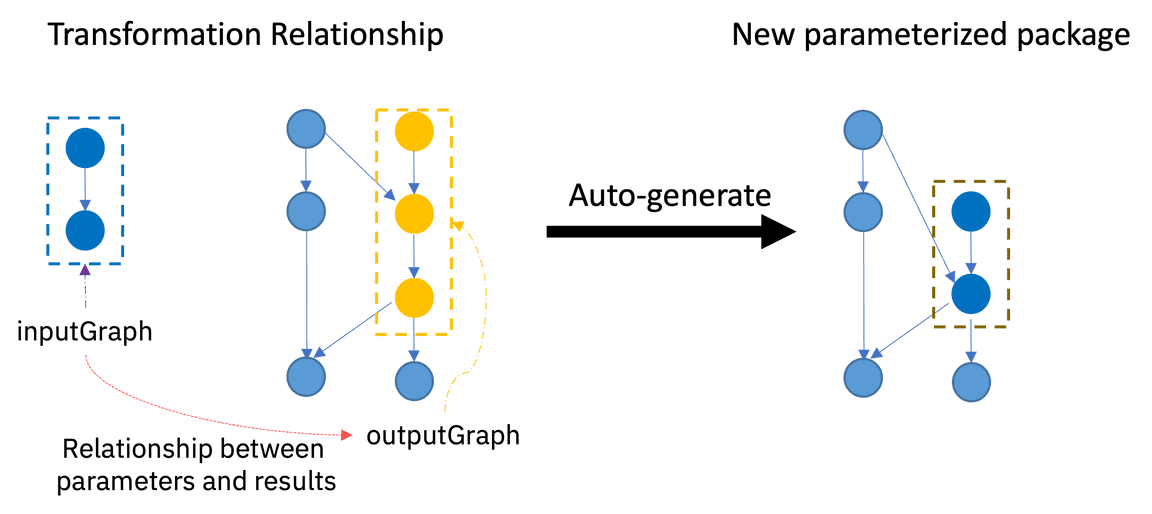Using graph relationships
Use this page to learn how to use define relationships between virtual experiment graphs. Readers should be familiar with the FlowIR specification of components.
- What is a relationship?
- Structure of a relationship
- Pushing a relationship to the runtime
- Automatically synthesize new parameterised packages
What is a relationship?
A core concept in ST4SD is the virtual experiment. A virtual experiment defines its execution logic in the form of a computational graph. This enables ST4SD to apply graph operations on the graphs of virtual experiments.
For example the runtime support of ST4SD for surrogate models performs a wide range of graph operations on the graphs of virtual experiments. It extracts sub-graphs from one or more virtual experiments, modifies them. Finally, it uses the transformed sub-graphs to update the graphs of different virtual experiment and even generate novel virtual experiments.
Structure of a relationship
ST4SD currently features one type of relationship which we term the transformation relationship.
A transformation explains how to replace the $outputGraph nodes in a target graph with transform($inputGraph) nodes from a source graph. Where transform() produces a graph that produces the same outputs as $outputGraph.
To achieve this, the transformation relationship defines how to:
- Map each of
$inputGraphto a parameter of$outputGraph(or a default value evaluated in the scope oftarget) - Map each result of
$outputGraphto a result of$inputGraph(or a default value evaluated in the scope ofsource).
Parameters of the inputGraph are variables and DataReferences that $inputGraph references which are not produced by nodes in the $inputGraph subset of the source graph.
The results of the $outputGraph are DataReferences which leftover nodes in the target graph consume which point to $outputGraph nodes.
Notice that parameters and results can be either DataReferences, variables, or strings which contain references to 0 or more variables. This means that the schema enables you to replace a DataReference in one graph with a string containing 0 or more references to variables of the other graph. In some cases this is a valid transformation action, but this is not the general case.
To this end, when you submit/update a transformation to the runtime service, the service will run tests to ensure that transformation can produce a valid experiment. Here are the rules that parameter and result mappings must follow:
- It is a valid operation to substitute a variable in one of the graphs with the value of another variable, or a
valuethat contains 0 or more references to variables in the other graph. - It is a valid operation to substitute a DataReference
Ain one of the graphs with a DataReferenceBin the other graph provided thatBis valid in the scope of the resulting experiment graph. - It is an invalid operation to substitute a variable in one of the graphs which is used in a place other than the command-line arguments of components with a DataReference
The schema of the relationship transformation (in YAML) is:
relationship:identifier: name of relationshiptransform: # there is currently only 1 type of relationshipinputGraph: # requiredcomponents: # required- component identifiers to include# must set exactly 1 of identifier or sourceidentifier: |the string identifier of an existing ParameterisedPackage
The runtime validates the transformation relationships by testing that:
- All inputGraph parameters have a relationship to an outputGraph parameter
- All outputGraph results have a relationship to an inputGraph result
Pushing a relationship to the runtime
You can submit a relationship to the ST4SD runtime-service API using the method experiment.service.db.ExperimentRestAPI.api_relationship_push().
Example: push a relationship
from __future__ import typingimport jsondef relationship_push(api: experiment.service.db.ExperimentRestAPI):"""Creates a Transformation relationship between 2 parameterisedpackages from the ST4SD global registryArguments:api: An instance of ExperimentRestAPI that has connected to yourprivate ST4SD registry
Automatically synthesize new parameterised packages
You can use a transformation relationship to automatically synthesize a novel virtual parameterised virtual experiment package like so:

A user can trigger the runtime to synthesize a new parameterised package by submitting a synthesis-from-transformation-relationship payload to the runtime service using the method experiment.service.db.ExperimentRestAPI.api_relationship_synthesize().
The structure (in YAML) of the payload is:
parameterisation:presets: # optional# Fields defined here *cannot* be overridden by `executionOptions`.# All fields are optionalvariables: #A list of preset values for variables in the virtual experiment- name: $name of variablevalue: $variableValuedata:- name: name of a file in the "data" directory
Side effects of synthesis step:
- The runtime service will create a novel parameterised package on the registry.
- The new parameterised package:
- will contain all components from the virtual experiment that contains
outputGraphexcept for those in theoutputGraph. The runtime system will substitute those for the components of the transformedinputGraph. - will have the parameterisation options specified in the
parameterisationfield of the schema above. - inherits the
interfaceof the virtual experiment that contains theoutputGraph
- will contain all components from the virtual experiment that contains
Example: use a transformation relationship to auto-generate a new parameterised package
from __future__ import typingimport jsondef relationship_synthesize(api: experiment.service.db.ExperimentRestAPI):"""Uses a transformation relationship to synthesize a new parameterisedpackage.Arguments:api: An instance of ExperimentRestAPI that has connected to yourprivate ST4SD registry